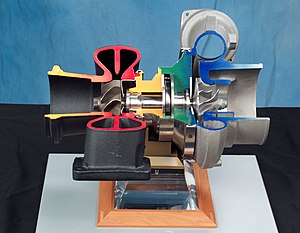
A turbocharger is actually a type of supercharger. Originally, the turbocharger was called a "turbo super charger." Obviously, the name was shortened out of convenience.

A turbocharger’s purpose is to compress the oxygen entering a car’s engine, increasing the amount of oxygen that enters and thereby increasing the power output. Unlike the belt-driven supercharger that is normally thought of when one hears the word "supercharger," the turbocharger is powered by the car’s own exhaust gases. In other words, a turbocharger takes a by-product of the engine that would otherwise be useless, and uses it to increase the car’s horsepower.

Cars without a turbocharger or supercharger are called normally aspirated. Normally aspirated cars draw air into the engine through an air filter; the air then passes through a meter, which monitors and regulates the amount of air that enters the system. The air is then delivered to the engine’s combustion chambers, along with a controlled amount of fuel from the carburetor or fuel injectors.
In a turbocharged engine, however, the air is compressed so that more oxygen will fit in the combustion chamber, dramatically increasing the burning power of the engine. The turbocharger is composed of two main parts: the compressor, which compresses the air in the intake; and the turbine, which draws the exhaust gases and uses them to power the compressor. Another commonly used term in relation to turbochargers is boost, which refers to the amount of pressure the air in the intake is subjected to; in other words, the more compressed the air is, the higher the boost.
Although the increase in power is advantageous to the car — and likely a source of enjoyment for the driver — a turbocharger has its drawbacks. First and foremost, a turbocharged engine must have a lower compression ratio than a normally aspirated engine. For this reason, one cannot simply put a turbocharger on an engine that was intended for normal aspiration without seriously undermining the life and performance of the engine. Also, a lower compression ratio means the engine will run less efficiently at low power.
Another major drawback of a turbocharger is the phenomenon known as turbo lag. Because the turbocharger runs on exhaust gases, the turbine requires a build-up of exhaust before it can power the compressor; this means that the engine must pick up speed before the turbocharger can kick in. Additionally, the inlet air grows hotter as it is compressed, reducing its density, and thereby its efficiency in the combustion chamber; a radiator-like device called an intercooler is often used to counter this effect in turbocharged engines.
Turbo lag
Turbo lag is the time required to change power output in response to a throttle change, noticed as a hesitation or slowed throttle response when accelerating from idle as compared to a naturally aspirated engine. This is due to the time needed for the exhaust system and turbocharger to generate the required boost. Inertia, friction, and compressor load are the primary contributors to turbo lag. Superchargers do not suffer this problem, because the turbine is eliminated due to the compressor being directly powered by the engine.Turbocharger applications can be categorized into to those that require changes in output power (such as automotive) and those that do not (such as marine, aircraft, commercial automotive, industrial, engine-generators, and locomotives). While important to varying degrees, turbo lag is most problematic in applications that require rapid changes in power output. Engine designs reduce lag in a number of ways:
- Lowering the rotational inertia of the turbocharger by using lower radius parts and ceramic and other lighter materials
- Changing the turbine's aspect ratio
- Increasing upper-deck air pressure (compressor discharge) and improving wastegate response
- Reducing bearing frictional losses (e.g., using a foil bearing rather than a conventional oil bearing)
- Using variable-nozzle or twin-scroll turbochargers
- Decreasing the volume of the upper-deck piping
- Using multiple turbos sequentially or in parallel
- Using an Antilag system
- Using a turbo spool valve to increase exhaust gas flow speed to the (twin-scroll) turbine
Boost threshold
The boost threshold of a turbo system is the lower bound of the region within which the compressor operates. Below a certain rate of flow, a compressor produces insignificant boost. This limits boost at a particular RPM, regardless of exhaust gas pressure. Newer turbocharger and engine developments have steadily reduced boost thresholds.Electrical boosting ("E-boosting") is a new technology under development. It uses an electric motor to bring the turbo up to operating speed quicker than possible using available exhaust gases. An alternative to e-boosting is to completely separate the turbine and compressor into a turbine-generator and electric-compressor as in the hybrid turbocharger. This makes compressor speed independent of turbine speed. In 1981, a similar system that used a hydraulic drive system and overspeed clutch arrangement accelerated the turbocharger of the MV Canadian Pioneer (Doxford 76J4CR engine).
Turbochargers start producing boost only when a certain amount of kinetic energy is present in the exhaust gasses. Without adequate exhaust gas flow to spin the turbine blades, the turbo cannot produce the necessary force needed to compress the air going into the engine. The boost threshold is determined by the engine displacement, engine rpm, throttle opening, and the size of the turbo. The operating speed (rpm) at which there is enough exhaust gas momentum to compress the air going into the engine is called the "boost threshold rpm". Reducing the "boost threshold rpm" can improve throttle response.
Key components of a turbocharger
The turbocharger has three main components:- The turbine, which is almost always a radial inflow turbine
- The compressor, which is almost always a centrifugal compressor
- The center housing/hub rotating assembly

No comments:
Post a Comment